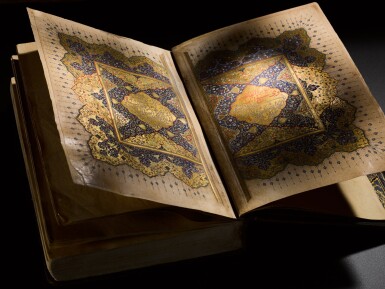Arts of the Islamic World & India including Fine Rugs and Carpets
Arts of the Islamic World & India including Fine Rugs and Carpets

An illuminated Qur'an, India, Mughal, second half 17th century
Auction Closed
October 26, 12:30 PM GMT
Estimate
20,000 - 30,000 GBP
Lot Details
Description
Arabic manuscript on paper, 347 leaves, plus 4 fly-leaves, with 12 lines of naskh in black ink in clouds reserved against a gold ground, ruled in gold, blue and black, verses separated by gold roundels, surah headings in white thuluth on gold floral illuminated panels, marginal markers in red, f.1b and f.2a with a double-page illuminated frontispiece, f.2b with illuminated headpiece surmounting text, f.191a with illuminated border, final folio with colophon with name of Yaqut al-Musta'simi, in gilt-stamped leather binding, brown leather doublures with filigree work in centre and corner spandrels
21.1 by 14.2cm.
The Mughal appreciation for the arts of Persia has been documented by the presence of Persian scribes in the Mughal court, and by the Persian volumes collected by Mughal emperors (Soucek 1987, p.166). By the seventeenth century, the style of most Indian Qur’ans was derived from Timurid and Safavid sources of the fifteenth and sixteenth centuries (Bayani, Contadini and Stanley 1999, p.200).
The headpiece on f.2b within this Qur’an is reminiscent of the illumination of Herat with a stronger use of black. The frontispiece, however, follows the Safavid Shiraz style of the mid-sixteenth century, and a Safavid Qur’an in the Khalili Collection that was re-illuminated in the Mughal court under Shah Jahan (r.1628-58) shows a similarly ambitious palette with lilac and orange highlights. The illuminated carpet page of this Qur’an is closely comparable both in terms of layout and quality as the frontispiece of a Mughal Qur’an sold in these rooms, 23 October 2019, lot 136.
